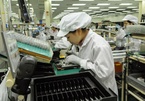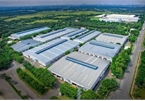US President Donald Trump has signed an executive order giving an outward investment agency new power to help US manufacturers produce everything the US needs, as well as exports, including medicine.

GE factory in Hai Duong province
Both Republicans and Democrats are drafting bills to reduce US dependence on Chinese-made products, accounting for about 18 percent of the US’s total imports in 2019.
The US companies that leave China may enjoy tax reductions or preferential policies, or even receive grants.
To promote this plan, US lawmakers and officials are discussing an investment fund to support relocation of overseas production bases to the home country with an initial budget of $25 billion. This aims to encourage US companies to change their relationship with China, including withdrawal from the ‘world’s factory’.
As such, the Covid-19 outbreak and worries about the reliance of US medical and food supply chains on China have strengthened the US’s determination to escape the reliance.
The Trump administration is also designing an economic prosperity network with the participation of reliable partners such as Japan, India, South Korea, Vietnam and New Zealand.
| Vietnam over the years attracted large US corporations such as Intel, Microsoft, Jabil, Microchip, IBM, P&G, Coca-Cola and PepsiCo. Later, Boeing, Chevron, AIG, Exxon Mobil and General Electric (GE) also sought investment opportunities in Vietnam. Most recently, Google and Apple reportedly are considering opportunities here. |
Vietnam over the years attracted large US corporations such as Intel, Microsoft, Jabil, Microchip, IBM, P&G, Coca-Cola and PepsiCo.
Later, Boeing, Chevron, AIG, Exxon Mobil and General Electric (GE) also sought investment opportunities in Vietnam. Most recently, Google and Apple reportedly are considering opportunities here.
Analysts said Vietnam can take full advantage of US investments in specific business fields, especially high-technology, to escape the middle-income trap.
US investment flow is expected to help improve the quality and efficiency of foreign direct investment (FDI), which has many problems.
In 2019, Vietnam attracted $38 billion worth of FDI, but the capital cannit meet the requirements in the country’s transition towards innovation, high quality human resources, digital economy and the 4.0 industry revolution.
The foreign invested projects were too small: 3,833 licensed projects had total registered capital of $16.75 billion. Some localities even licensed projects capitalized at $1-2 million.
Vietnam has put high hopes on the US new investment wave. At a meeting with 45 US businesses seeking investment opportunities in Vietnam recently, Alex Feldman, chair of the US-ASEAN Business Council, said Vietnam has become a promising destination for foreign investors, including the US, in recent years.
Vietnam attracted $12.33 billion in FDI in the first four months of 2020, according to the Foreign Investment Agency (FIA).
Le Ha

Vietnam needs to proactively seek high-quality FDI: economist
Vietnam must not sit still and wait for FDI to come. If it does, the best will be skimmed off by other countries, according to Nguyen Dinh Cung, a respected economist.

IZs development needs planning to attract FDI
The development of industrial zones (IZs) needs a comprehensive plan to capture the transition of the foreign direct investment (FDI) inflow spurred by trade wars and the COVID-19 pandemic
 Large-scale production relocating out of China is offering a golden opportunity for Vietnam to attract high-quality US investment." itemprop="description" />
Large-scale production relocating out of China is offering a golden opportunity for Vietnam to attract high-quality US investment." itemprop="description" />